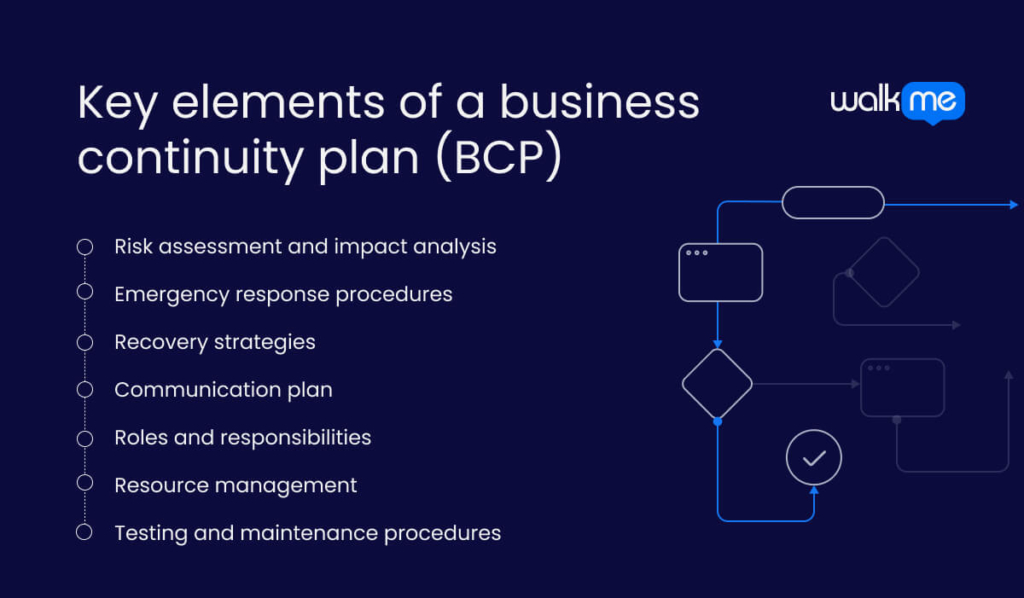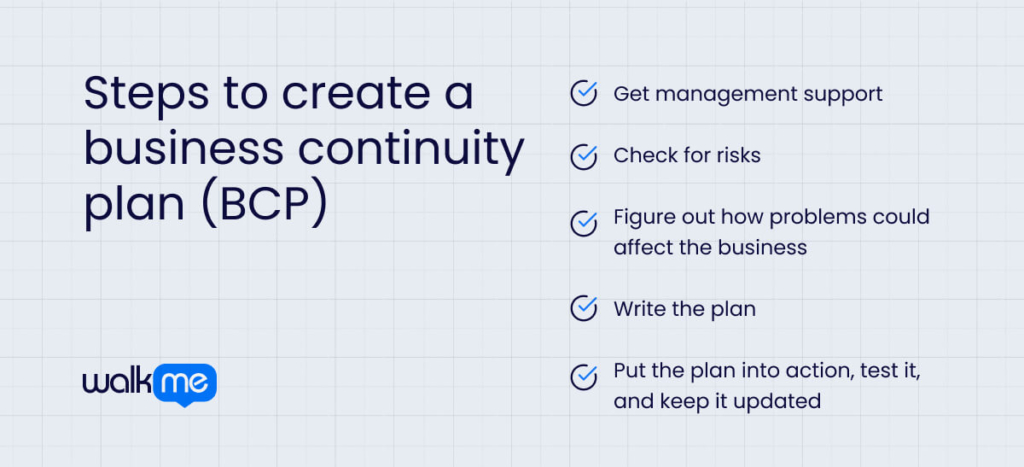All businesses face and manage risks.
Natural disasters, cybersecurity attacks, and global health crises can all disrupt normal operations and harm a company’s finances, reputation, and survival.
That’s where a business continuity plan (BCP) comes in.
A BCP is a roadmap that helps a company work during and after a crisis. It covers all parts of a business, from IT systems to employee safety.
A good BCP can mean the difference between a company bouncing back or shutting down after a disaster.
This article will explore what a BCP is, why it’s important, how to create one in five steps, and what key parts it should have.
What is a business continuity plan (BCP)?
A business continuity plan (BCP) is a detailed plan that outlines how a company will continue to operate during and after an emergency.
A BCP is not just about fixing IT problems; it covers all parts of a business. It includes plans for staff, equipment, data, and customer service. The main goal of a BCP is to help a business get back to normal quickly after a problem.
It aims to reduce lost time and money, keep customers happy, and maintain trust in the company.
Why is a business continuity plan (BCP) important?
Today’s business world is full of risks.
SolarWinds says small businesses lose about $427 every minute when they can’t work. Big companies lose even more, up to $9,000 per minute.
These numbers show why having a plan to keep your business running during problems is so important. A good plan can help you avoid losing money and recover quickly.
BCPs are crucial for many reasons. They help companies act fast in emergencies, which saves money. A strong BCP protects a company’s good name by showing it’s prepared. It also keeps employees safe and secure in their jobs, helping keep morale and productivity high during tough times. By law, many industries also require companies to have BCPs.
Recent studies show why BCPs matter. The Federal Emergency Management Agency (FEMA) reports that 40% of small businesses never reopen after a disaster, and a quarter of them close within a year.
Key elements of a business continuity plan (BCP)

Understanding the components of a business continuity plan is vital for organizations seeking to safeguard their operations and recover from potential disruptions.
Let’s take a closer look at the key elements:
Risk assessment and impact analysis
Systematically identify and evaluate potential threats to the organization. Assess each risk’s likelihood and impact on operations, finances, and reputation. This foundational step informs all subsequent aspects of the BCP, ensuring resources are allocated effectively to address the most critical vulnerabilities.
Emergency response procedures
Building on the risk assessment, develop clear, actionable protocols for immediate crisis response. This includes employee safety measures, initial damage assessment processes, and procedures for activating the crisis management team. These procedures form the crucial first line of defense in minimizing the impact of a disruptive event.
Recovery strategies
Informed by the risk assessment, create detailed plans to restore critical business functions. Outline specific steps for various scenarios, including IT system recovery, alternative operational processes, and supply chain management. These strategies provide a roadmap for swiftly returning to normal operations after a disruption.
Communication plan
Develop a comprehensive strategy for both internal and external communications during a crisis. This plan, crucial for maintaining stakeholder trust, should include defined roles, pre-prepared message templates, and protocols for regular updates. Effective communication supports all other aspects of the BCP by ensuring a clear, consistent information flow.
Roles and responsibilities
Clearly define the crisis management team’s structure and duties. Assign specific responsibilities for each phase of the BCP, from initial response to full recovery. This clarity ensures efficient plan execution and prevents confusion during high-stress situations.
Resource management
Based on the recovery strategies, identify and plan for all necessary resources. This includes personnel, equipment, facilities, and external partnerships. Effective resource management ensures the organization can quickly mobilize and deploy assets when implementing recovery strategies.
Testing and maintenance procedures
Establish a robust system for regularly testing, reviewing, and updating the BCP. This includes scheduled exercises, result analysis, and improvement implementation. Consistent testing and maintenance ensure the plan remains relevant and effective, adapting to changes in the business environment and incorporating lessons from simulations or actual incidents.
Steps to create a business continuity plan (BCP)

Developing a business continuity plan requires a systematic approach that guides organizations through the process of preparing for and responding to potential disruptions.
Let’s take a look at the steps needed to create a BCP:
Get management support
Gaining digital leadership buy-in is crucial for the success and effectiveness of any business continuity plan.
- Review past plans and incidents to identify gaps
- Present BCP benefits: reputation protection, customer satisfaction, competitive advantage
- Share success stories and cautionary tales from other companies
- Determine recovery time objectives with leadership input
- Align BCP with the company’s overall risk approach
Check for risks
A risk analysis identifies potential threats to the organization and forms the foundation of a robust business continuity plan.
- Identify potential disruptions: natural disasters, cyber-attacks, power outages, supply chain issues, and health emergencies
- Categorize risks by type and severity
- Assess the likelihood and potential impact of each risk
- Involve various departments in comprehensive risk identification
- Utilize methods like PESTLE analysis or ISO 31000 guidelines
Figure out how problems could affect the business
A thorough business impact analysis helps prioritize critical functions and allocate resources effectively during a disruption.
- Estimate potential financial losses, operational impacts, and reputational damage
- Identify critical business functions and recovery priorities
- Determine necessary resources for maintaining essential operations
- Involve key stakeholders from different departments
- Establish recovery time objectives for various business areas
Write the plan
Creating a comprehensive plan ensures all team members can effectively respond to and recover from disruptions.
- Include plan scope, objectives, and responsibilities
- Detail immediate emergency actions and communication protocols
- Outline recovery strategies and resource requirements
- Assign specific tasks to individuals or teams
- Based on your integrated risk assessment, create plans for different scenarios
- Incorporate plans for remote working and digital tools
Put the plan into action, test it, and keep it updated
Regular implementation, testing, and updates ensure the BCP remains relevant and effective over time.
- Inform all employees of their roles and provide easy plan access
- Conduct regular training sessions, especially for key personnel
- Test the plan through tabletop exercises and full-scale simulations
- Review and improve based on test results and lessons learned
- Update at least annually or when significant business changes occur
BCP vs. disaster recovery
While both aim to protect organizations from disruptions, business continuity planning, and disaster recovery focus on different aspects of organizational resilience.
Business continuity planning (BCP)
BCP is a proactive approach that focuses on maintaining critical business functions during and after a disruptive event. It encompasses various scenarios and aims to keep the entire organization operational. BCP involves identifying essential processes, creating preventive measures, and establishing procedures for quick recovery.
Disaster recovery (DR)
Disaster recovery is a subset of BCP that specifically deals with restoring IT infrastructure and systems after a disaster. It focuses on the technical aspects of recovery, including data backup, system restoration, and network reconfiguration. DR plans are typically more focused and technical, detailing the steps to resume normal IT operations following a disruptive event.
BCP: Your business lifeline
In today’s uncertain business world, having a solid business continuity plan is no longer optional—it’s a must.
A well-designed BCP can help your organization weather crises, minimize downtime, and gain an advantage over competitors.
Remember, creating a BCP is not a one-time task. It’s an ongoing process that needs regular review and updates to stay effective.
Following the steps outlined in this guide and including the key components discussed, you can develop a comprehensive BCP that makes your organization more resilient and thrive even in tough times.
As recent world events have shown, unexpected things can happen anytime. With a solid BCP in place, your organization will be better prepared to face whatever challenges come your way, ensuring your business can keep running and succeed in the long term.
FAQs
To write a BCP plan, assess risks and their potential impacts. Then, develop strategies for emergency response, recovery, and communication. Assign roles and responsibilities, outline necessary resources, and create testing procedures. Regular reviews and updates are crucial for maintaining an effective plan.
A BCP example might include plans for a power outage. This would cover:
- Immediate safety procedures
- Steps to switch to backup power
- Communication protocols for staff and customers
- Strategies to maintain critical operations during the outage
- Methods to fully restore normal functions once power is restored
The four pillars of business continuity are:
- Risk assessment: Identifying potential threats
- Impact analysis: Evaluating effects on business operations
- Recovery strategies: Developing plans to restore functions
- Testing and maintenance: Ensuring the plan remains effective

